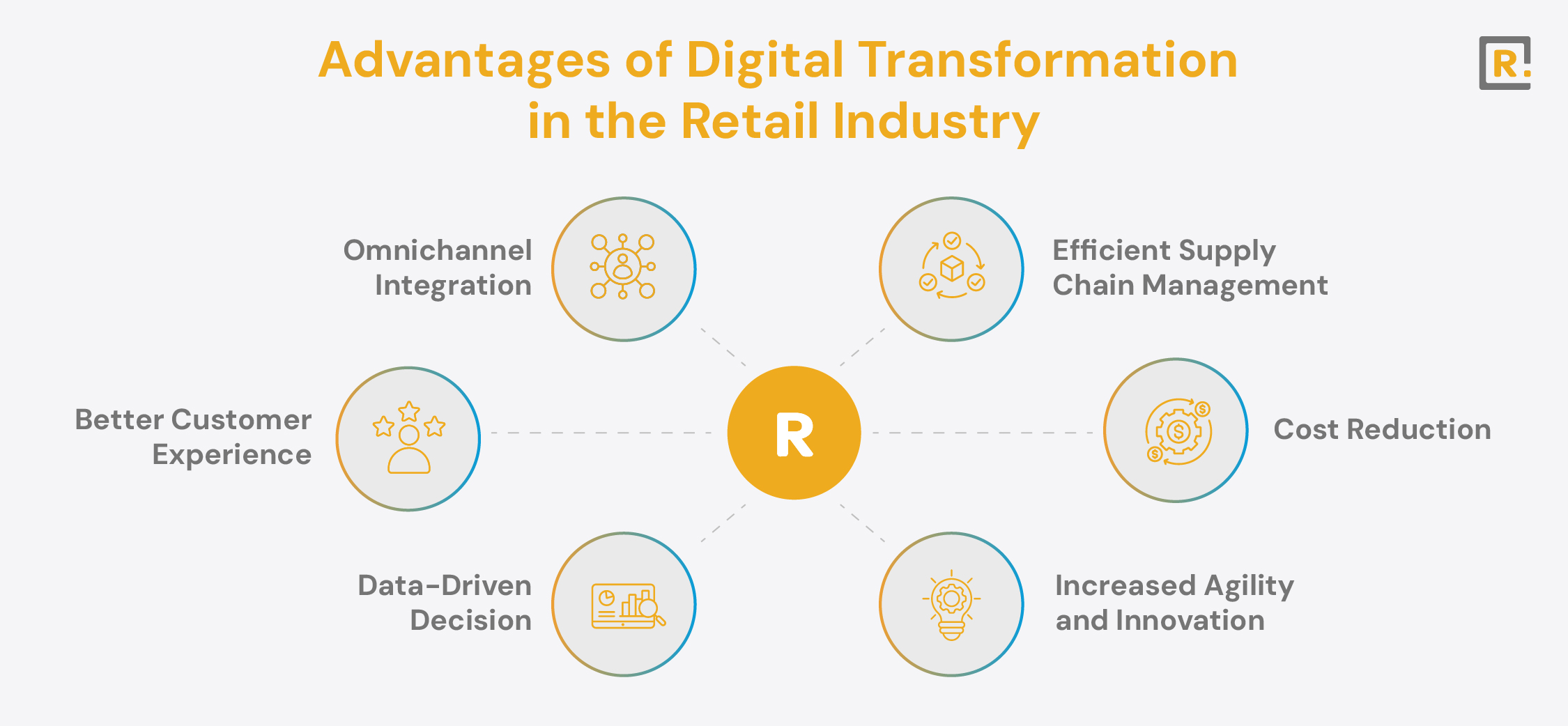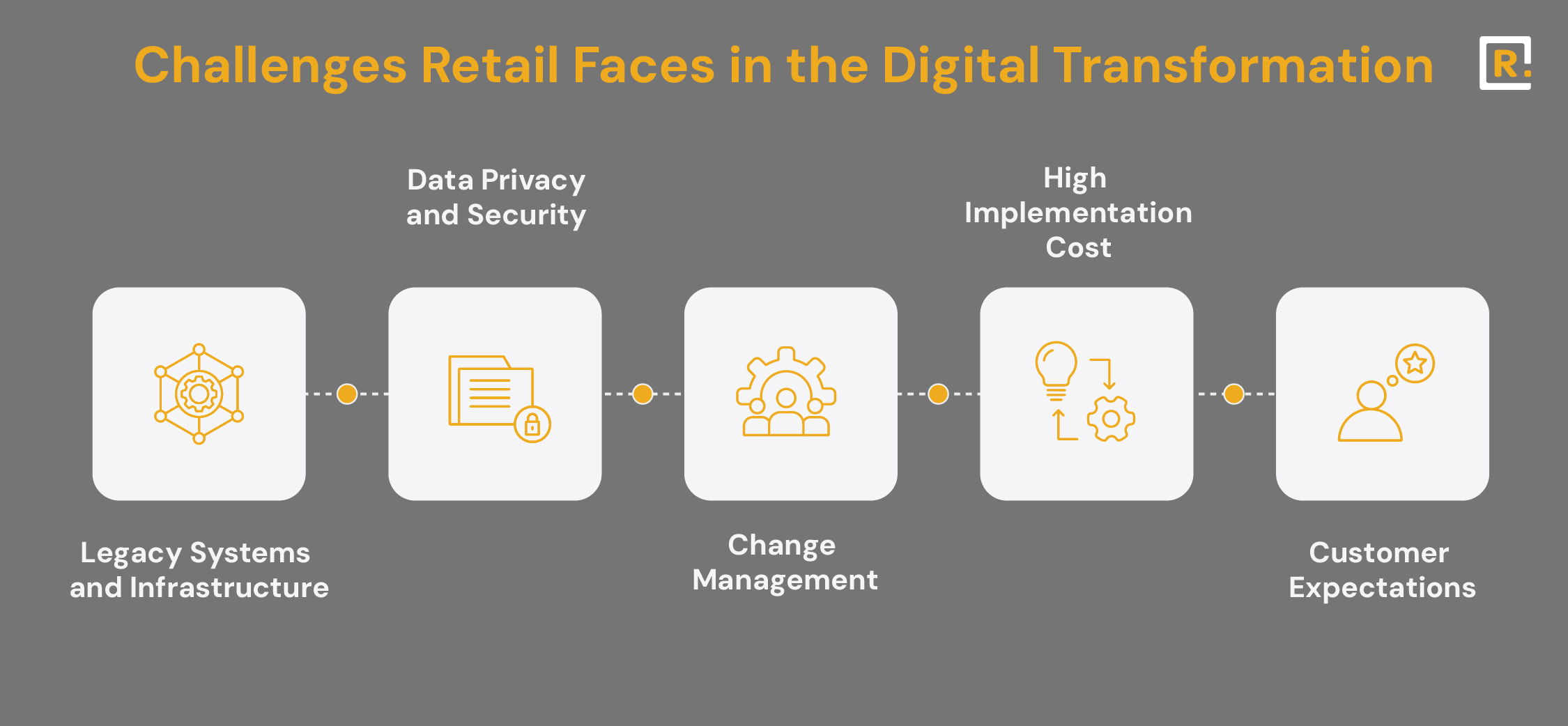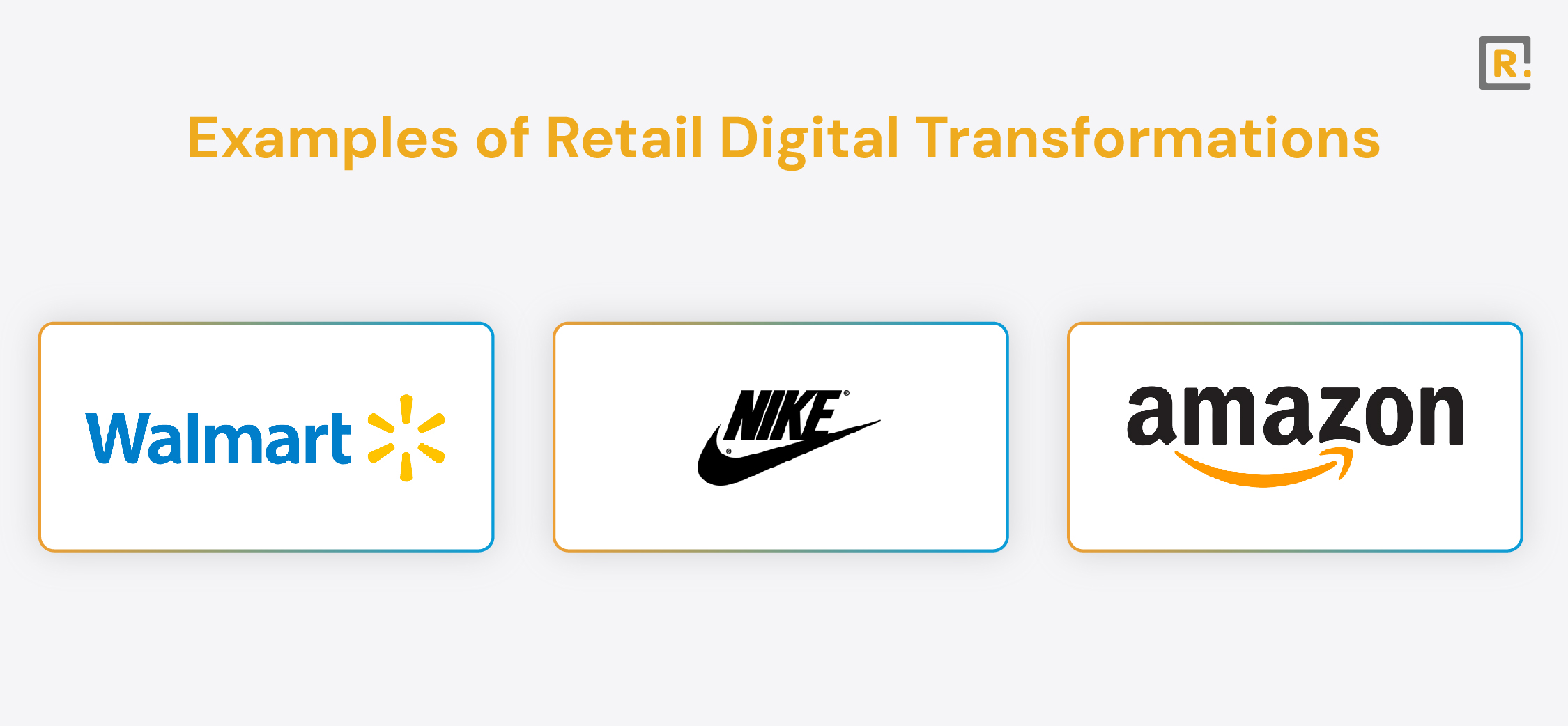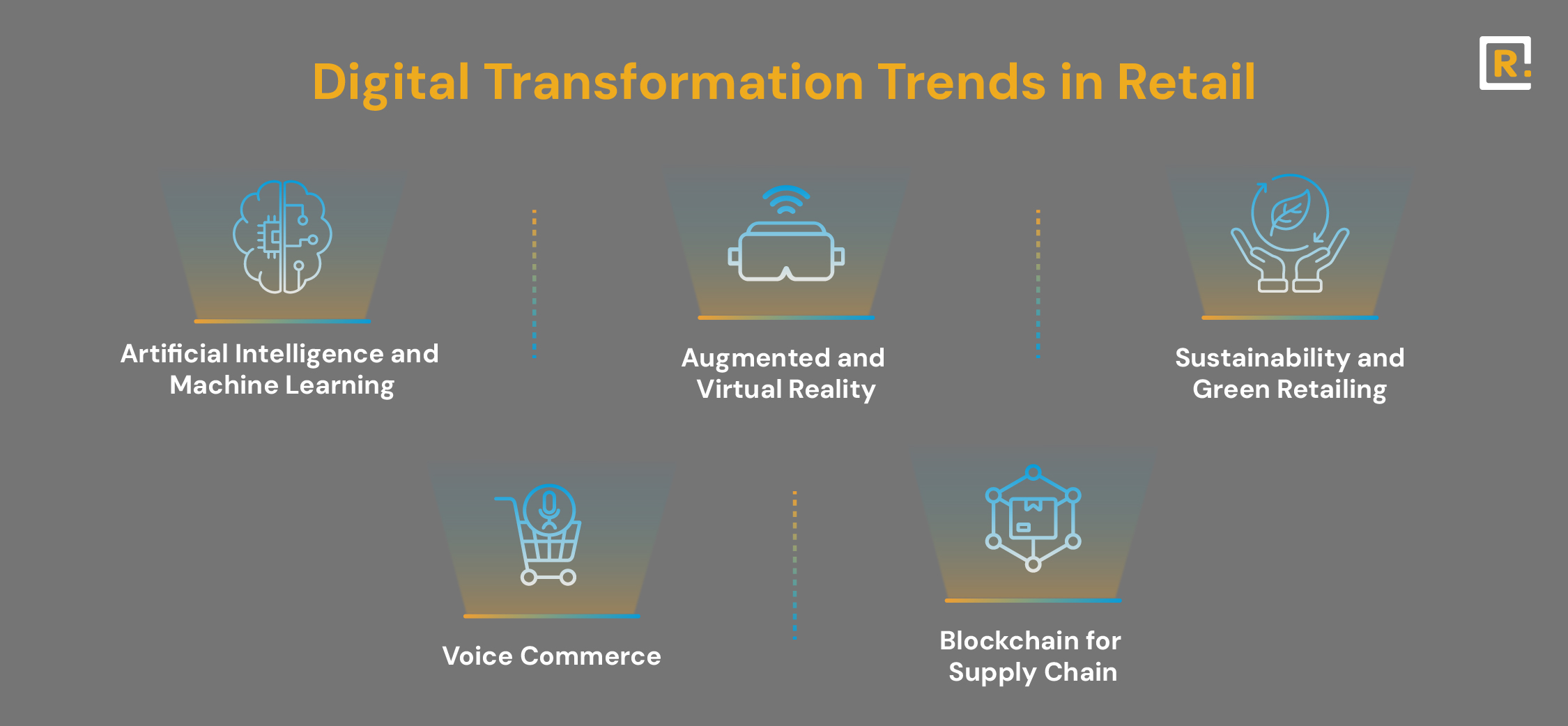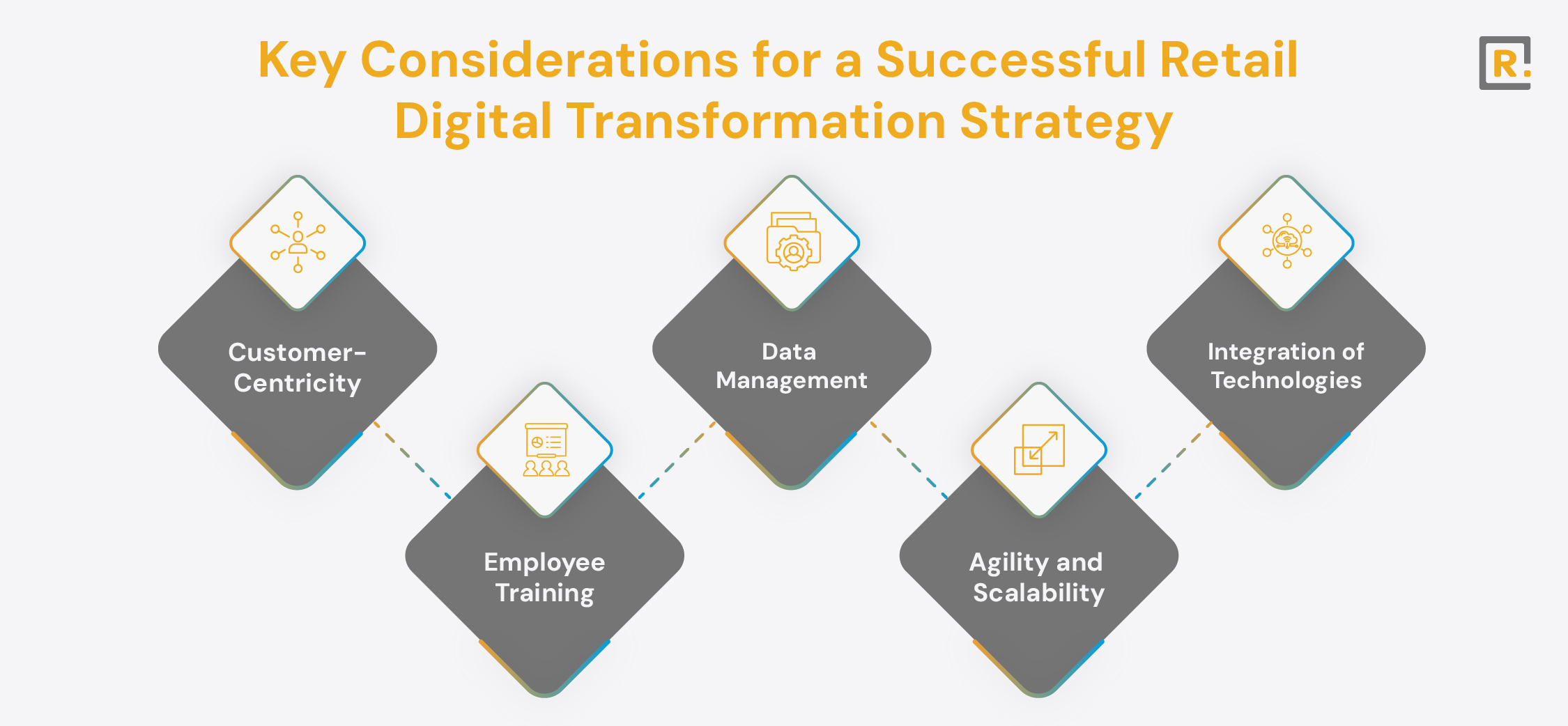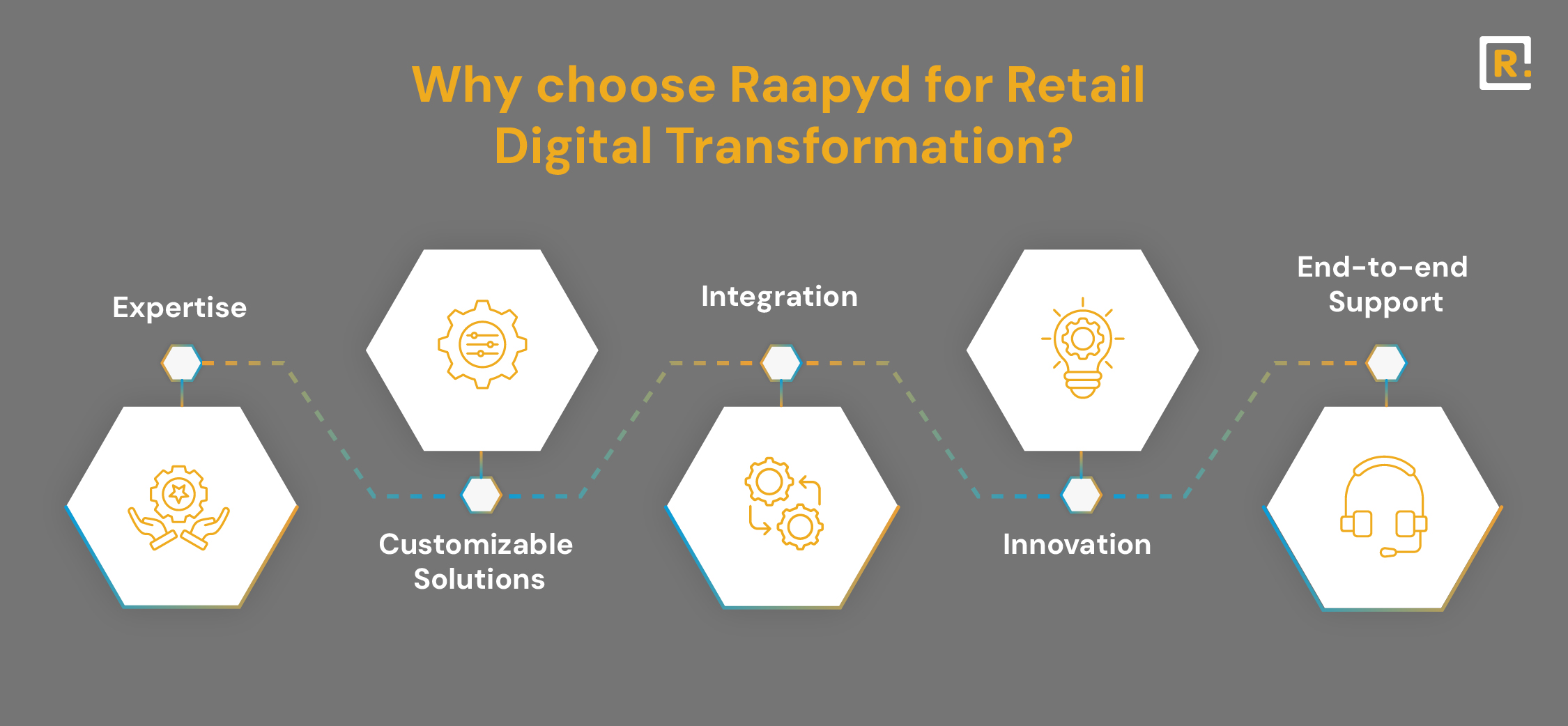-
Solutions
Vendor Management Efficient vendor management platformField Service Management Effective onsite service operationsReal Estate Management Efficient real estate managementAsset Management Efficient asset lifecycle managementDistribution Management System Optimized supply chain distributionDigital Retail Solution Integrated e-commerce solutionsSubscription and Billing System Automated billing and subscriptionsSales Force Automation Optimized sales process automationIntelligent Character Recognition Software Automated text conversion and data extraction
- Why Raapyd
- Insights
- About
Digital Transformation in Retail: Benefits and Challenges
- Retail
- Digital Retail Solution

The retail industry is changing quickly because of the internet. Things that were important in the past are not important now.
Because things are changing so fast, stores need to change to meet the needs of people using the Internet more. Stores need to move from having physical locations to selling things online. This will help them keep up with what customers want, improve their operations, and improve how they help customers.
Even though there are many good things about making these changes, it is hard for stores to do. This blog will talk about the different parts of changing a store to be more digital. Keep reading to discover the good things, the problems to avoid, and the strategies to make these changes successful.
What Is Retail Digital Transformation?
Digital transformation in retail is a concept that fuses brick-and-mortar operations with the Internet.
Digital transformation entails adopting all innovative tools, platforms, and processes that will increase efficiency and quality of service. It also involves customer engagement and results in new revenue streams. The concept also covers customer service, inventory management, supply chain logistics, marketing, and sales.
The transformation to digital retail involves more than just adding technology; it also means rethinking and reorganizing how retail businesses operate. This process moves retailers towards focusing on customers, using data-driven insights to create seamless, personalized shopping experiences and journeys across different channels.
Digital retail transformation also includes automating important behind-the-scenes tasks, such as managing inventory and logistics in supply chains. It also involves integrating tools to make operations more efficient, using technologies like artificial intelligence, big data analytics, and the Internet of Things.
Advantages of Digital Transformation in the Retail Industry
The benefits range from elemental changes to efficiency and customer satisfaction to monumental leaps in profitability. Here are some of the key benefits a retailer can unlock with the use of a digital-first approach:
Better Customer Experience
One of retail digital transformation’s most significant driving forces is the struggle to change customer experiences. Consumers today want an experience with their brands, and digitization works similarly.
It seamlessly integrates, personalizes, and touches all touchpoints in-store, on the website, or even in a mobile application. What’s more? The process also includes a mix of AI-driven chatbots, recommendation engines, and AR to facilitate hyper-customized shopping experiences.
Using digital platforms also enables business owners to collect customer data that reveals shopping behaviors, preferences, and pain points. The data can then be used to tailor marketing strategies, optimize product recommendations, and provide more relevant customer support.
Omnichannel Integration
Retailers are using digital transformation to connect their online and offline channels and create a unified customer experience. More and more retailers offer the option to “buy online, pick up in-store.” Customers can buy products online and pick them up at a nearby store, giving customers more choices and helping stores manage their inventory.
Omnichannel integrations allow customers to interact with a brand through different channels, such as mobile apps, websites, and social media. Retailers use these connected channels to keep all customer data in one place, providing a better experience at every interaction.
Data-Driven Decision
Retailers use digital transformation to gather information about customer interactions, inventory movement, and sales. This data helps them make smarter business decisions. By analyzing the data, retailers can learn about customer preferences, market trends, and operational issues. They can use this information to predict demand, set prices, and manage inventory better. For example, predictive analytics can help retailers stock the products that customers want, reducing the risk of overstocking or running out of stock.
Efficient Supply Chain Management
The retail industry has improved its supply chain thanks to digital transformation. Technologies like IoT and Blockchain allow companies to have better visibility and trace their value chains more effectively. This helps them reduce delivery delays and meet schedules. IoT uses sensors and devices to track inventory levels, shipment locations, and warehouse conditions in real-time, providing retailers with information about reorders or reroutes. This ensures transparency and secure transactions in the supply chain.
Increased Agility and Innovation
The retail industry constantly changes, and digital transformation allows retailers to adapt. It allows them to quickly build a flexible and scalable digital infrastructure to try new business models. This also helps them introduce new products and meet the needs of consumers more effectively.
For example, it lets retailers quickly add new features to cloud-based platforms. They can also create mobile payment systems or loyalty programs with fewer IT resources. This flexibility helps retailers stay competitive in a fast-changing industry and keep innovating to meet customer expectations.
Cost Reduction
Digital transformation can help retailers save money. It can make operations more efficient, reduce the need for manual work, and automate regular tasks.
For example, AI-powered chatbots can handle customer inquiries, reducing the need for human agents. This also decreases the chance of errors in managing inventory, as automation cuts the labor costs of manual inventory checks.
Additionally, using cloud-based systems has a positive impact on reducing physical infrastructure, which lowers operation and maintenance costs. By investing in digital technologies, retailers can optimize operations and reduce costs, ultimately improving their profitability.
Challenges Retail Faces in the Digital Transformation
The benefits of digital transformation in retail come with a hidden bounty of challenges. There is a list of challenges one will face while implementing digital initiatives; therefore, understanding them cannot be overstated.
Legacy Systems and Infrastructure
Many retailers operate on legacy systems, which fail to host different digital tools and platforms. These systems are expensive and extremely cumbersome to upgrade, and these tools often require a total overhaul of the existing infrastructure. Merging new technologies with legacy systems causes compatibility problems, inducing delays and disturbances to the transformation process.
Data Privacy and Security
Data privacy and security have been major concerns for businesses lately. The increasing use of the internet has opened gates for hackers and data thieves to steal crucial customer data. These include data breaches, hacking incidents, and other cybersecurity threats that seriously make companies vulnerable.
What’s more? Robust security protocols go a long way in ensuring that sensitive customer data is adequately protected. Financial fines, which motivate firms to comply with data protection laws such as the GDPR and CCPA, are also legal liabilities for failure to comply.
Change Management
Digital transformation is a mandate in today’s digital world, but organizational cultural change is always tricky. Since the typical problem is resistance to change, the scenario is similar even here in the case of digital transformation.
Retail firms must invest in change management initiatives, such as training programs and communication strategies, to usher in a culture shift and prepare for new technologies and processes.
High Implementation Cost
While digital transformation has long-term cost savings, the initial investment in digital tools and various digital platforms is hefty.
Retailers must invest heavily in implementing new technologies, upgrading existing systems, and employee training. Small and mid-sized retailers also need help justifying the upfront costs despite the long-term benefits of digital transformation.
Customer Expectations
With more retailers joining the digital transformation bandwagon, customer expectations are higher than ever. Customers expect quick and smooth personalized experiences online and in-store.
To meet expectations, it requires huge investments in technology, data analytics, and customer service. Retailers who keep up with changing consumer needs lose their customers to competitors with advanced digital experiences.
Examples of Retail Digital Transformations
Some, such as Walmart, have pushed this digital transformation agenda well. Let’s examine these three examples to see how retail digital transformation accomplishes that.
Walmart
Wal-Mart has heavily invested in digital transformation to compete in e-commerce by enhancing its online platform, mobile apps, and in-store technology.
This “Scan & Go” feature of Wal-Mart allows customers to scan items with their smartphones while shopping in-store, reducing checkout times. Walmart has thus sought automation of supply chain and logistics processes with the help of robotics and AI. Automation enables efficiency in the process.
Nike
Nike has shifted towards digital transformation, adhering to and blending its physical stores with an online presence. It recently launched the Nike app, giving personalized product recommendations and special offers, with the option of reserving an item for pick-up in stores. The brand has also invested heavily in data analytics to understand customer preferences, helping shape its marketing strategy.
Amazon
Amazon is the best example of how digital transformation changes the nature of the in-store experience. The brand is currently focusing on driving all its resources to improve customers’ shopping experience. It has integrated VR product experience, multiple shipping options, and regional languages to get better customer acquisition and sales.
Digital Transformation Trends in Retail
Retail is constantly changing because of new technology. Retailers must keep up with these changes to give their customers the best experience.
Artificial Intelligence and Machine Learning
AI, with machine learning, helps in everything from customer service to inventory optimization. AI-powered chatbots, recommendation systems, and virtual shopping assistants assist customers in addressing their challenges with personalized experiences.
Augmented and Virtual Reality
The customer-product interaction is changing with AR and VR. For this, retailers are building their competency in AR technologies to offer customers options to try some clothing, makeup, or accessories virtually. Regarding this matter, storekeepers use VR technologies to make the customer’s in-store experience more immersive.
Sustainability and Green Retailing
Consumers are increasingly concerned about the environment. As a result, retailers are integrating sustainability into their business strategies. They are using biodegradable packaging and selling products made from sustainable materials. Digital tools are also being used to support these environmental practices.
Voice Commerce
As a result, voice commerce is finding a more prominent niche in modern society due to the improved availability of voice assistant technologies such as Amazon Alexa and Google Assistant. For that reason, retailers have been developing their sites to enable voice search capabilities and allow placing orders through voice using customer requests, making the shopping process smoother.
Blockchain for Supply Chain
The retail industry increasingly adopts blockchain technology to enhance transparency within its supply chain. Transparent tracking from manufacturers to clients in the blockchain is safe and unchangeable, as it records every deal, enabling the retailer to be confident about the goods or products’ authenticity and integrity.
Key Considerations for a Successful Retail Digital Transformation Strategy
For retail businesses, a host of factors must be seriously considered to implement digital transformation successfully. The following considerations should be taken by a retailer embarking on a journey to a digital transformation:
- Customer-Centricity: Create value and deliver it in unique, personalized, seamless ways to the customer.
- Data Management: Investment in solid data management and analytics tools for action-oriented insights.
- Integration of Technologies: New digital technologies will be integrated into prevailing systems and processes.
- Employee Training: Adequately trained employees must become accustomed to using new technologies.
- Agility and Scalability: Choose digital tools and platforms that keep the same pace as the business.
Why choose Raapyd for Retail Digital Transformation?
As a leading provider of solutions to transform digital retail, Raapyd enables retailers to access the support they need to navigate the complexities of the digital age.
Raapyd’s digital-first solutions power customers to elevate experiences, optimize operations, and fuel business development.
Here are some reasons why the solution stands out:
- Expertise: Raapyd understands the retail business and its challenges in the digital era.
- Customizable Solutions: Raapyd’s digital transformation solutions are tailored to meet the needs of each retailer, whether a small boutique or a large chain.
- Integration: Raapyd ensures its solutions are seamlessly integrated into retailers’ systems, which seldom require effective changes.
- Innovation: Raapyd is always on the edge of the latest trends in digital transformation, assuring that retailers will have access to corresponding technological advances.
- End-to-end Support: Raapyd offers end-to-end support on a fruitful digital transformation journey, from planning to implementation.
Conclusion
Digital transformation in retail is no longer a trend but a necessity for modern companies to reach a competitive edge within the market. It is impacting retail in significant ways. It benefits the customer experience while improving operational efficiencies. However, retailers must be mindful of their challenges and create a detailed strategy to navigate them successfully.
With a customer-centric view, investment in the right technologies, and a trusted partner like Raapyd, retailers can unlock their full potential, raised by digital transformation, to be sure they are positioning themselves for success in the digital age.
Discover More
Transform Your Retail Business with Digital Solutions
Unlock the power of seamless integration and innovation with Raapyd’s retail digital transformation services.
